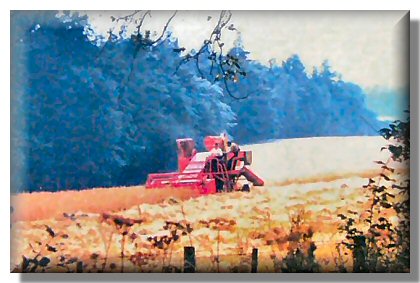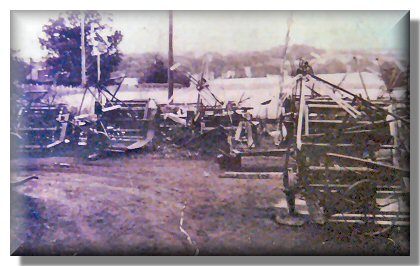The Sickle
The sickle, or heuk, was used for cutting till the first half of the 19th Century. Extra workers (mainly women) were employed to wield the sickles, bind up the sheaves or to stook the corn.
On large farms, 50 or more women could be seen bent at the sickles, while others bound up the sheaves or stooked them.
The Inverness Courier of 13th August 1828 had this to say:
“Hundreds of Highland peasants, male and female are now migrating to the south for employment during the harvest. We met 150 near Moy, journeying in parties according to their respective districts and each accompanied by a piper. The greater part were from Sutherland and the Black Isle.”
The Scythe
It was in the 19th century that scythes were first used to harvest grain, with farms in the North leading the change from the sickle.
Using a scythe was a job for a man, as more muscle power was needed.

There were three in each scythe team, two men and one woman. One man cut the grain, the woman gathered it up into bundles, while the other man bound up the sheaves and stooked them.
Though harvesting with the heuk or scythe resulted in many thistle “stobs” or nettle stings for the gatherers and stook builders, these were probably the happiest days of the farming year.
Combine Harvester
The “combine” arrived in Scotland in 1932 and reached Orkney by 1950.

It was designed to cut, thresh and dress grain in one operation and its arrival changes the harvest landscape and patterns of work. The days of stooks and corn stacks ended and the days of large open fields followed.
The picture shows Willie Jack, Rosehaugh Mains and Donny Patience at the field along the Low Road (Rosehaugh East Drive) about 1960.
The Binder
The reaper cut the corn, while the binder cut, made up and tied the sheaves with twine. Scythes were still used to cut “roads” around the edges of fields, to allow the Clydesdales and machines to make the first circuit. Three Clydesdales were needed to pull the heavy binder, which cut a swathe five feet wide. Binders were notorious for breaking down, as they often lay rusty and unattended all year until harvest time.

The photograph of a binder in action was taken at Bay Farm. Also shown (below) are binders waiting for repair at Newhall smithy.

